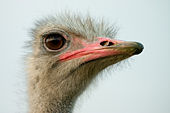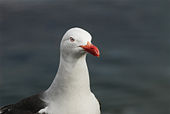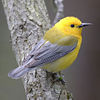Modern birds
| Modern birds Fossil range: Cretaceous - Recent |
||||||||
|---|---|---|---|---|---|---|---|---|
 Ostrich, a paleognath
 Dolphin Gull, a neognath
|
||||||||
| Scientific classification | ||||||||
|
||||||||
| Superorders | ||||||||
|
Paleognathae |
Modern birds (subclass Neornithes) are the members of class Aves that have survived into recent times and have coexisted with humans. Modern birds are characterised primarily by their toothless beaks, as most prehistoric bird groups possessed teeth.
Many species of modern bird undertake long distance annual migrations, and many more perform shorter more irregular movements. They are primarily socially monogamous, with engagement in extra-pair copulations being common in some species; other species have polygamous or polyandrous breeding systems. Eggs are usually laid in a nest and incubated and most birds have an extended period of parental care after hatching.
Contents |
Taxonomy
Modern birds are divided into two superorders, the Paleognathae (mostly flightless birds like ostriches), and the wildly diverse Neognathae, containing all other birds. Depending on the taxonomic viewpoint, the number of species cited varies anywhere from 8,800 to 10,200 known living bird species in the world. It is generally agreed that the Neornithes evolved in the Cretaceous Period and that the split between the Galloanserae (fowl) and the other Neognathae occurred before the K-T extinction event, but there are different opinions about whether the radiation of the remaining neognathes occurred before or after the extinction of the other dinosaurs.[1] This disagreement is in part caused by a divergence in the evidence, with molecular dating suggesting a Cretaceous radiation and fossil evidence supporting a Tertiary radiation. Attempts made to reconcile the molecular and fossil evidence have proved controversial.[1][2]
The classification of modern birds is a contentious issue. Sibley & Ahlquist's Phylogeny and Classification of Birds (1990) is a landmark work on the classification of birds, although frequently debated and constantly revised. A preponderance of evidence seems to suggest that the modern bird orders constitute accurate taxa. However, scientists are not in agreement as to the relationships between the orders; evidence from modern bird anatomy, fossils and DNA have all been brought to bear on the problem but no strong consensus has emerged. More recently, new fossil and molecular evidence is providing an increasingly clear picture of the evolution of modern bird orders. See also: Sibley-Ahlquist taxonomy and dinosaur classification.
Classification
This is a list of the taxonomic orders in the subclass Neornithes, or modern birds. The list of birds gives a more detailed summary of these, including families.
Subclass Neornithes
Paleognathae:
- Struthioniformes, Ostrich, emus, kiwis, and allies
- Tinamiformes, tinamous
Neognathae:
- Anseriformes, waterfowl
- Galliformes, fowl
- Gaviiformes, loons
- Podicipediformes, grebes
- Procellariiformes, albatrosses, petrels, and allies
- Sphenisciformes, penguins
- Pelecaniformes, pelicans and allies
- Ciconiiformes, storks and allies
- Phoenicopteriformes, flamingos
- Falconiformes, falcons, eagles, hawks and allies
- Gruiformes, cranes and allies
- Charadriiformes, gulls, button-quail, plovers and allies
- Pteroclidiformes, sandgrouse
- Columbiformes, doves and pigeons
- Psittaciformes, parrots and allies
- Cuculiformes, cuckoos, turacos, hoatzin
- Strigiformes, owls
- Caprimulgiformes, nightjars and allies
- Apodiformes, swifts and hummingbirds
- Coraciiformes, kingfishers
- Piciformes, woodpeckers and allies
- Trogoniformes, trogons
- Coliiformes, mousebirds
- Passeriformes, passerines
Note: This is the traditional classification (the so-called Clements order). A radically different classification based on molecular data has been developed (the so-called Sibley-Monroe classification or Sibley-Ahlquist taxonomy). This has influenced taxonomic thinking considerably, with the Galloanserae proving well-supported by recent molecular, fossil and anatomical evidence.[1] With increasingly good evidence, it had become possible by 2006 to test the major proposals of the Sibley-Ahlquist taxonomy, with favorable results (see for example Charadriiformes, Gruiformes or Caprimulgiformes).
Phylogeny

Basal divergences of modern birds based on the Sibley-Ahlquist taxonomy.
| Neornithes |
|
|||||||||||||||||||||||||||
References
- ↑ 1.0 1.1 1.2 Ericson PGP, Anderson CL, Britton T, Elzanowski A, Johansson US, Kallersjo M, Ohlson JI, Parsons TJ, Zuccon D, Mayr G (2006)"Diversification of Neoaves: integration of molecular sequence data and fossils" Biology Letters 2(4): 543-547
- ↑ Brown J, Payne B, & Mindell D (2006) "Nuclear DNA does not reconcile 'rocks' and 'clocks' in Neoaves: a comment on Ericson et al. Biology Letters 3 1-3
|
||||||||||||||||||||||||||
|
||||||||||||||||||||
